from shipwrecks to science fairs
The Center for Science and Mathematics Education finds innovative ways to engage students and teachers
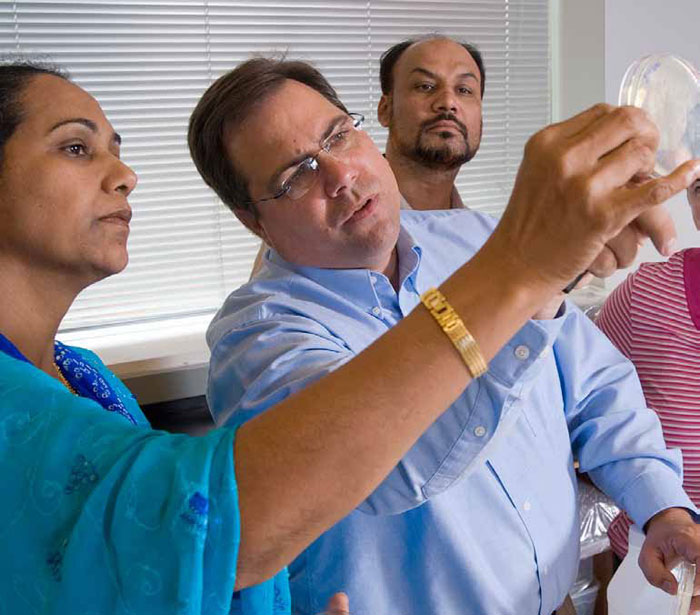
During a summer course titled “Walking in Darwin’s Footsteps,” James Bader (center) and Cleveland-area teachers look for evidence of mutation in bacteria.
Of all the current reform efforts in American education, few have won greater support than the drive to improve instruction in the so-called STEM fields—science, technology, engineering and mathematics. The federal departments of education and labor have launched major initiatives to prepare students for STEM careers. Ohio legislators approved $200 million in STEM-related spending for 2007-2009. Some of these funds went toward creating small high schools, including two in Cleveland, with science and technology themes.
Advocates believe that such programs are needed to address longstanding deficiencies in STEM education. “Too many of our elementary school students lose interest in science and mathematics by the time they reach the middle grades, and too many of our high school graduates are unprepared for college and the workforce,” according to the Ohio STEM Learning Network, which provides funding and technical assistance to schools throughout the state. Along with other STEM proponents, the network has called for reforms across the “education continuum,” from preschool through college.
James Bader, director of the Center for Science and Mathematics Education (CSME), shares this agenda. Since 1998, he and his colleagues in the College of Arts and Sciences have worked to enhance instruction and generate student interest in the STEM fields. They have helped high school teachers incorporate lab experiments into the curriculum and engaged middle school students in authentic research. And each spring, during family days on the Case Western Reserve campus, they invite younger children and their parents to discover that “Science is Fun.”
For Bader and assistant director Kathryn Kwiatkowski, the recent burst of interest in STEM education couldn’t be more welcome. It validates the work they were already doing, and it opens up additional opportunities for support and collaboration. “We engage with a wide swath of partners, both within the university and beyond,” Bader explains. At Case Western Reserve, students as well as faculty members take part in the center’s activities. Its external partners include schools and public libraries, park systems, science museums, research centers and foundations. Through these relationships, Bader says, the center furthers the university’s agenda in STEM education.
Demonstrating Commitment
Even before CSME was founded, college faculty were sharing their expertise with K-12 students and teachers. In the early 1990s, for example, Christopher Cullis, the Frances Hobart Herrick Professor of Biology and current chair of the department, developed a series of high school workshops on biotechnology—a field so new it hadn’t yet appeared in the textbooks. The series lasted two weeks and was open to 60 students at a time. Cullis also designed experiments to accompany the workshops, and he raised funds for a program to lend the required lab equipment to the schools.
Bader managed that program, and soon afterward he began recruiting faculty members to provide professional development for teachers. With colleagues Martin Rosenberg and Ana Locci, he developed a summer course on terrestrial and aquatic ecology. Classes met at the University Farm, and the teachers returned with their students during the school year for a day-long field experience. The biology department funded the course through a grant from the Howard Hughes Medical Institute.
—James Bader
CSME was created to coordinate initiatives like these, Bader explains. In addition, its early supporters wanted it to collaborate with outside programs that were successful at getting young people excited about science. Edward Lowenthal (ADL ’66), a former co-chair of the college’s visiting committee, first broached the idea for the center, and he demonstrated his commitment by providing the start-up funds. His generosity soon inspired other donors. With encouragement from Ellen and Bruce Mavec of Cleveland, The Kelvin and Eleanor Smith Foundation awarded grants to CSME in each of its first two years. And in 2000, the center received a major gift from Elizabeth Downs Charpie (FSM ’46) and her husband, Dr. Robert A. Charpie, of Weston, Massachusetts.
One of CSME’s first collaborations was with the JASON Project, an earth and space exploration program devoted to science education. Founded by Dr. Robert Ballard, who discovered the remains of the Titanic, JASON transmits broadcasts from research expeditions to the ocean’s depths, to Peruvian rainforests and even to the eyes of hurricanes. As the first JASON site in northeast Ohio, the center attracted thousands of students and their teachers to campus, where they watched the broadcasts in Ford Auditorium and asked questions, in real time, of the participating scientists.
Today, the center has ties to another of Ballard’s projects. Immersion Presents, a web-based exploration series, provides curricula for afterschool science programs. CSME incorporates some of its activities into a summer camp for 12- to 15-year olds.
Kwiatkowski has managed the center’s partnerships since it was founded. She didn’t actually start out as a science educator; her background is in sociology and public administration. But, she says, if programs like Ballard’s had been available to her while she was growing up, she might have gone into science herself.
A Robust Science Experience
In 2000, when Bader took over the center from founding director Lawrence Badar, he expanded its outreach to area teachers. With a six-year grant from the National Science Foundation, he established a mathematics and science partnership with the Cleveland metropolitan schools and started bringing teachers to campus for intensive summer courses.
“At all levels, teachers need opportunities to stay up on what’s current in their disciplines and to refresh their fundamental knowledge,” he explains. “Even a veteran physics teacher can benefit from a refresher course on Newton’s laws. Of course, the laws haven’t changed in the past 20 years. But having a chance to investigate them again, and the ways they are connected to other topics, is important. And these are needs that the university is well positioned to address.”
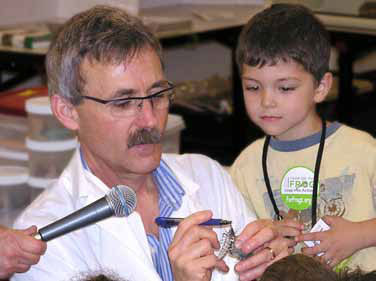
Mark Willis, associate professor of biology, shows off the finer points of moth anatomy to a captivated student during the Science is Fun! Family Day program.
As the partnership evolved, however, Bader realized that focusing on teachers’ content knowledge wasn’t enough. “There weren’t very many labs being taught in Cleveland high schools,” he recalls. Teachers were unfamiliar with “the whole process of constructing a robust science experience—designing their own experiments, identifying proper variables, manipulating the equipment, making sure the protocols ran smoothly.” So CSME expanded the summer curriculum to cultivate these skills.
“In the sciences, we built in these multi-day experiments that the teachers did from start to finish,” Bader says. “Then we ended the course with a poster session in Hovorka Atrium. The chemistry and biology groups would come together and look at each other’s posters. It was a really good way to examine the entire process, from conceiving of an idea to asking a question, right up to presenting the results and defending them before your peers. We had them try this model in the hope that they could replicate it in their classrooms.”
Chemistry teacher Sandra Ammon went on to do just that. After four years in the program, she came away with a repertoire of experiments she felt confident about. “When you get these labs, you know they’re going to work,” she explains. “You don’t have to worry that you will set up a lab for your first-period class, have it fail and then be stuck with it for the rest of the day.”
When Ammon enrolled in the partnership, she was the only chemistry teacher at Jane Addams High School. For the first time in her career, the program gave her the chance to share ideas with other teachers in her discipline, both during the summer and at meetings throughout the year. It also provided funds for equipment and supplies so that she and her colleagues could implement a lab-based curriculum.
Today, as a teacher at the School of Architecture and Design on the John Hay campus, Ammon enhances her lessons with knowledge she gained from working with college faculty. For instance, she tells students about the time she spent doing nanochemistry with associate professor Clemens Burda, whose research explores the energy-generating potential of infinitesimal particles of gold. At the nanoscale, Ammon explains, gold has unexpected properties; it is cranberry colored, and absorbs light at the same wavelength as some natural pigments. For this reason, chemists and engineers are hoping to use nano-sized gold on solar cells and panels.
Ammon wants her students to grasp the importance of such research. “Nanotechnology is going to do for the next 20 years what computers did for the last 20 years,” she tells them. She hopes they will remember her words and be inspired to pursue scientific careers.
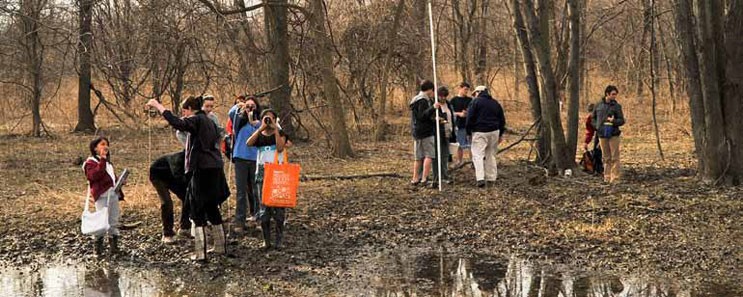
Students in the Environmental Heroes program measure water quality at the Ohio & Erie Canal Reservation, part of the Cleveland Metroparks system.
Exploring Lakes and Wetlands
Faithful to its origins, CSME continues to engage directly with young people. Each February, it draws as many as 600 middle and high school students to campus for the Northeast Ohio Regional Science Olympiad. This isn’t just a matter of opening up a few buildings on a Saturday; the center enlists faculty, staff, students and alumni to oversee scores of science and engineering events.
Two newer initiatives offer students more sustained experiences in STEM education. The first is a two-week summer camp that builds on middle schoolers’ fascination with shipwrecks. Participants visit the Peachman Lake Erie Shipwreck Research Center and use its online resources to hunt for lost vessels from the late 19th and early 20th centuries. They learn about the weather conditions that lead to shipwrecks, and the geological formations on the lake floor where the ruins come to rest.
In addition, since this is a camp, the youngsters take canoe trips and scuba diving lessons, practice land and sea navigation, and build small, remotely operated vehicles that they launch on tranquil voyages across Wade Lagoon in University Circle.
The center’s partners for Shipwreck Camp include Cleveland Lakefront State Park and the Cuyahoga County Public Library, which holds related events for children, families and teachers throughout the year. All of these activities are supported by a grant from the Martha Holden Jennings Foundation.
A second new program engages middle schoolers in biological fieldwork. Developed in collaboration with Cleveland Metroparks, Environmental Heroes is conducted year round at the Ohio & Erie Canal Reservation, a 4.4-square-mile wildlife habitat that runs through the villages of Cuyahoga Heights and Valley View.
Students in the program “invest time in learning about science, but they also conduct real research that is of benefit to the park system,” Kwiatkowski says. So far, they have tested water quality in the reservation, analyzed the distribution of amphibians and reptiles, and assessed the spread of invasive plant species. They know that by collecting good data, they are contributing to efforts to conserve the park.
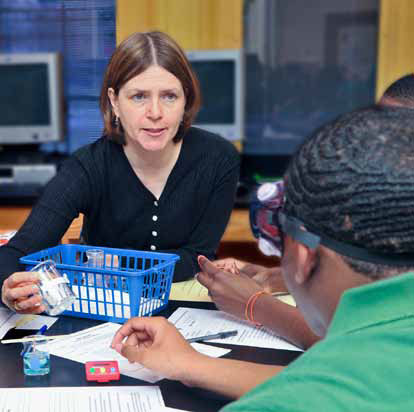
Chemistry teacher Sandra Ammon has her students do lab experiments with supplies she obtained through the Cleveland Mathematics and Science Partnership.
The students often meet with biology faculty members and with staff scientists from Cleveland Metroparks. One visiting researcher showed them how he uses radio telemetry to track the migration patterns of Blanding’s turtles. Kwiatkowski asks, “How many kids go out into the field with a frog specialist or a turtle researcher? How can you do that without a program?”
Before they joined Environmental Heroes, few of the students had ever examined the natural world at close range. The experience has made them into acute observers and listeners. In February, weeks before the official beginning of spring, the youngsters heard the first frog calls rising from the reservation’s vernal pools. Once they learned what a chorus frog sounded like, they could distinguish it from a leopard frog or a wood frog. Eventually, Kwiatkowski says, they will mark and recapture these creatures as part of a wildlife census.
An Unexpected Impact
Finally, thanks to a recent gift from Mark Gelfand, CSME has begun providing mentors to Cleveland students working on science fair projects. The mentors, known as the Gelfand Science and Engineering Fellows, are all Case Western Reserve undergraduates or graduate students, and many were once science fair winners themselves.
After the first 18 fellows were selected last fall, they got some preliminary coaching from Bader and Nancy DiIulio, a former biology instructor who is now an undergraduate dean. Together, they reviewed the district’s science curriculum to see what children at each grade level are expected to know. They discussed strategies for helping students generate meaningful questions, design valid experiments and analyze the results. Then the fellows fanned out to 20 schools across the city.
Ramya Raman, a senior biochemistry major, worked with students at John F. Kennedy High School. “I started by asking them what their hobbies are, what they like to do for fun, and then tried to see if we could come up with research questions from that,” she said. “I challenged the students to create something that was really their own, something they could connect to. That was the most important step.”
Taking their interests as the starting point, Raman guided her students through some unusual experiments. One young woman, an inveterate shopper, devoted her project to shoe styles; she wanted to assess the pain that girls incur by wearing heels of different sizes. She designed a survey that captured the amount of walking the subjects did and the number of hours they wore the shoes in question.
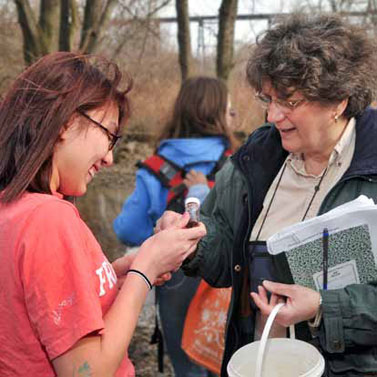
Catie Abood (left), 15, a student in the Environmental Heroes program, examines macroinvertebrates with Kathryn Kwiatkowski, CSME’s assistant director.
From a project like this, Raman says, the young woman could go on to study the anatomy of the foot. “We’re trying to tie the project to science and still make it something they can relate to and have fun with,” she explains. “If they have fun with science, maybe they will continue doing it.”
In some cases, the Gelfand Fellows helped students obtain equipment for their projects. At Forest Hill Parkway Elementary School, Sarah Lukowski, a sophomore psychology major, advised a group of sixth graders who wondered how much air they took in with each breath. Lukowski asked her mother, a public health nurse, for a box of peak flow meters. Other supplies were less obviously scientific. A team of seventh graders wanted to test the effectiveness of football helmets in blunting the impact of a blow. But since their school has no football team, it has no helmets, either. Lukowski got the university’s athletic department to donate one.
The two Gelfand fellows found it an advantage to be relatively close in age to their students; they had musical tastes and other cultural reference points in common. But they also gained respect as Case Western Reserve undergraduates and as women scientists.
“You are a model for them,” Lukowski says. “When you tell them their project is a good project, they light up 10 times more than they do when the teacher tells them. They start believing in themselves.”
Forest Hill Parkway held its science fair in mid-February, and with one exception, every student participated. “They all did something, they all had a board and they all were excited to talk,” Lukowski recalls. “Even though I already knew most of their projects, they wanted to go through their speech with me and tell me all about it.” Near the bottom of several boards, she noticed a line reading, Thank you to Case Western Reserve and to Sarah for helping us.
“I didn’t know I had made that much of an impact,” Lukowski says. But to anyone familiar with the center’s contributions to STEM education, it comes as no surprise.
